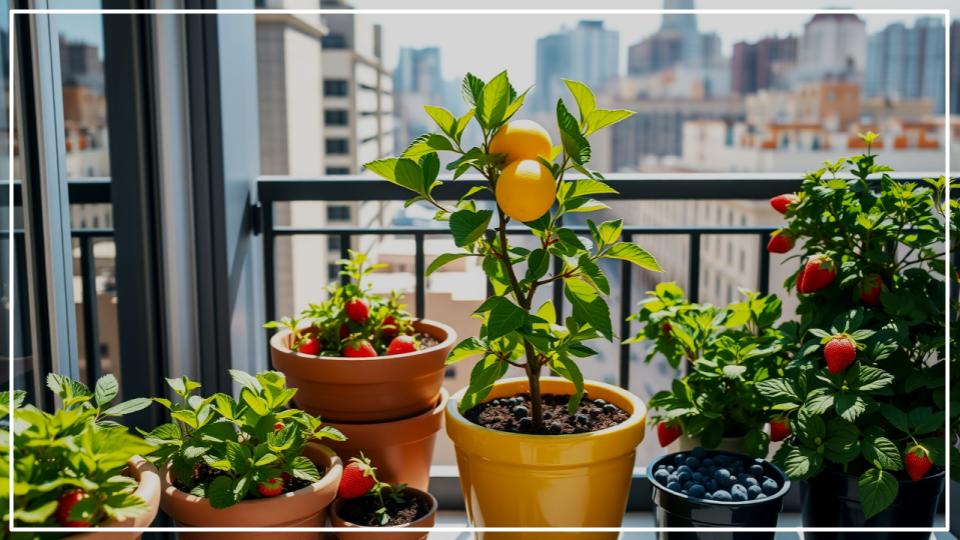
The dream of harvesting your own sun-ripened fruit, still warm from the vine, often conjures images of sprawling orchards and rambling gardens. But what if I told you that even the tiniest balcony or a sun-drenched patio could become your personal fruit haven? It’s true! The art of growing fruits in pots opens up a world of delicious possibilities, transforming compact spaces into productive and beautiful oases. Forget limitations; embrace the ingenuity of container gardening. This guide will walk you through eight delectable fruits that not only thrive in containers but can bring surprising bounty and a touch of elegance to your outdoor living area. Prepare to be amazed at what you can cultivate, just steps from your door.
Quick Tips for Potted Fruit Success
Here’s what you need to know for thriving balcony fruit gardening:
- Choose Wisely: Opt for dwarf varieties or those specifically recommended for containers.
- Pot Power: Select pots large enough for root growth with excellent drainage. Bigger is often better!
- Sunlight is Key: Most fruits need at least 6-8 hours of direct sunlight daily.
- Water Well: Potted plants dry out faster. Water deeply when the top inch or two of soil is dry.
- Feed Regularly: Container fruits require consistent nutrients. Use a balanced fertilizer appropriate for fruiting plants.
Why Grow Fruits in Pots? The Sweet Rewards
The allure of growing fruits in pots extends far beyond the simple joy of a fresh bite. For those with limited space, it’s a game-changer, offering access to flavors and experiences previously thought out of reach. I’ve always believed that a garden, no matter its size, is a source of immense satisfaction. Potted fruits bring that unique joy to balconies, patios, and even sunny windowsills.
Beyond the practical aspect of utilizing a small space edible garden, container fruit gardening allows for greater control over your plant’s environment. You can tailor soil mixes to specific needs—acidic for blueberries, well-draining for citrus—and easily move plants to optimize sunlight or protect them from harsh weather. Plus, the aesthetic appeal of a miniature orange tree laden with fruit or a cascade of strawberries is simply undeniable, adding a touch of sophisticated, edible beauty to your home.
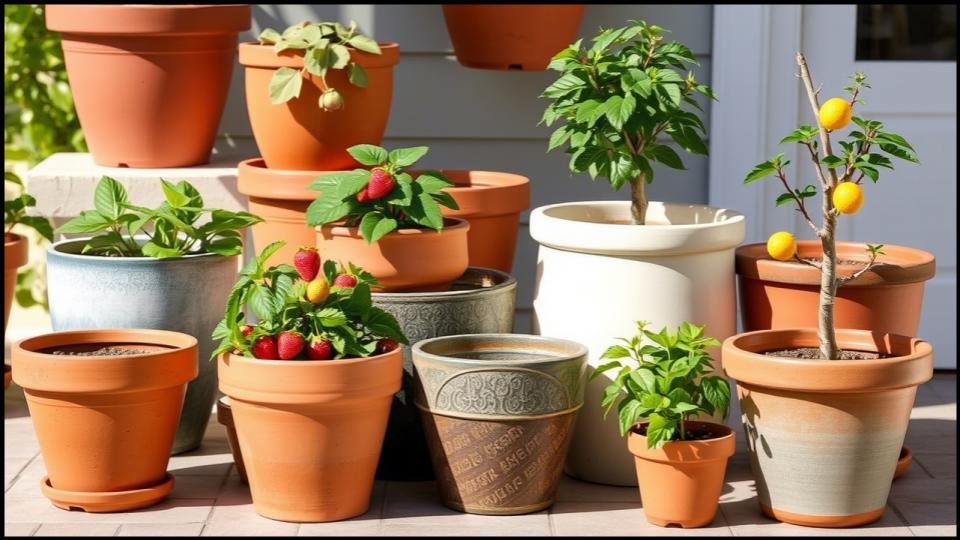
Choosing Your Container Champions: 8 Fruits Perfect for Pots
Not all fruit plants take kindly to confinement, but many thrive, and some even prefer it with the right care. The key is selecting the right container fruit varieties and understanding their specific needs. Let’s explore some of my personal favorites that deliver big on flavor and charm.
Strawberries (Fragaria x ananassa)
The quintessential container fruit, strawberries are wonderfully adaptable and incredibly rewarding. Whether you choose June-bearing types for one large harvest or everbearing varieties for a steady supply throughout the summer, they are perfect for hanging baskets, window boxes, or classic pots. In my experience, even a few well-tended strawberry pots can produce a surprising amount of sweet, juicy berries.
- Why they’re great for pots: Shallow root systems; many compact varieties available.
- Pot Size: At least 6-8 inches deep and wide per plant, or larger planters for multiple plants.
- Varieties to Try: ‘Albion’ (everbearing), ‘Chandler’ (June-bearing), ‘Seascape’ (everbearing). Alpine strawberries (Fragaria vesca) are also delightful, offering tiny, intensely flavored fruits.
- Care Tips: Full sun (6-8+ hours). Well-draining potting mix rich in organic matter. Keep soil consistently moist, especially during fruiting. Feed with a balanced liquid fertilizer every 2-3 weeks during the growing season.
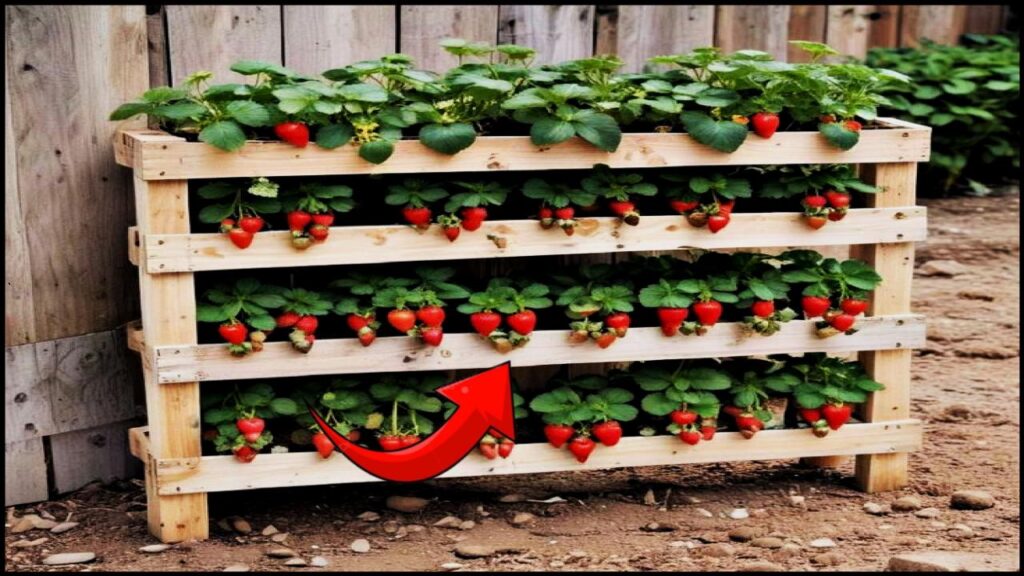
Blueberries (Vaccinium corymbosum hybrids)
Imagine stepping onto your balcony to pluck a handful of fresh blueberries for your morning cereal. With compact or dwarf varieties, this is entirely achievable. The key to happy blueberries is acidic soil—something easily controlled in a pot. I always recommend a soil test kit or using a pre-mixed ericaceous compost.
- Why they’re great for pots: Many smaller cultivars are available; allows for specific acidic soil requirements.
- Pot Size: Start with a 12–14-inch diameter pot, moving up to 18-24 inches as the plant matures.
- Varieties to Try: ‘Top Hat’ (dwarf, self-pollinating), ‘Pink Popcorn’ (unique pink berries), ‘Patriot’ (early season, cold hardy). Look for varieties described as “compact” or “patio.”
- Care Tips: Full sun. Acidic, well-draining soil (pH 4.5-5.5). Use rainwater, if possible, as tap water can be alkaline. Mulch with pine bark or needles. Fertilize with an acid-specific fertilizer. The Royal Horticultural Society has a great guide to growing blueberries.
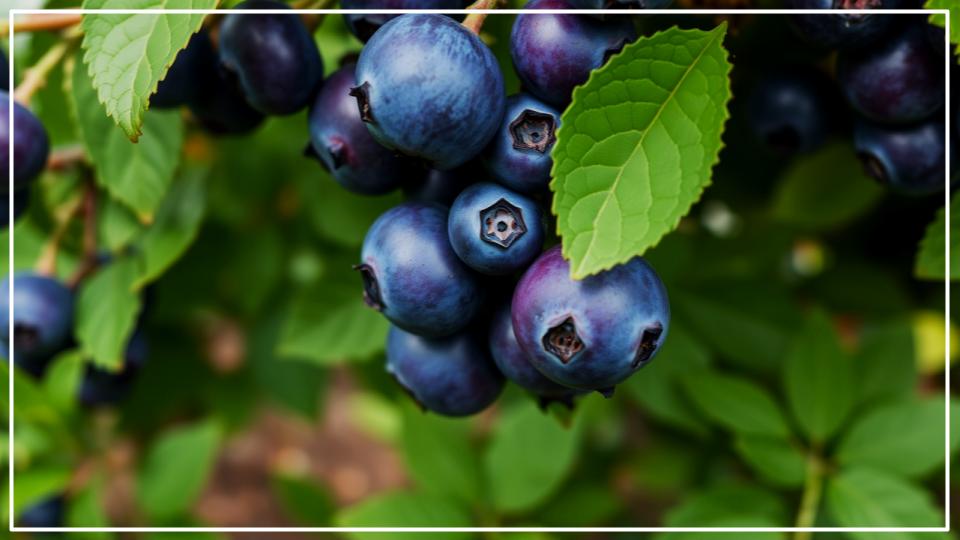
Meyer Lemon (Citrus x meyeri)
Few things are as elegant as a potted Meyer lemon tree, with its glossy green leaves, fragrant blossoms, and of course, those beautiful, thin-skinned, sweet-tart lemons. These trees are naturally smaller than other lemon varieties, making them ideal for container fruit trees. My own Meyer lemon brings such cheer to my sunroom in winter and patio in summer.
- Why they’re great for pots: Relatively small size, very productive, highly ornamental.
- Pot Size: Begin with a 12-inch pot for a young tree, eventually moving to a 20–24-inch pot or half-whiskey barrel.
- Varieties to Try: ‘Improved Meyer’ is the standard and most readily available.
- Care Tips: At least 8 hours of bright sunlight. Well-draining potting mix. Water thoroughly when the top 2-3 inches of soil are dry. Feed regularly with a citrus-specific fertilizer, especially during spring and summer. Protect from frost; they can be brought indoors in cooler climates.
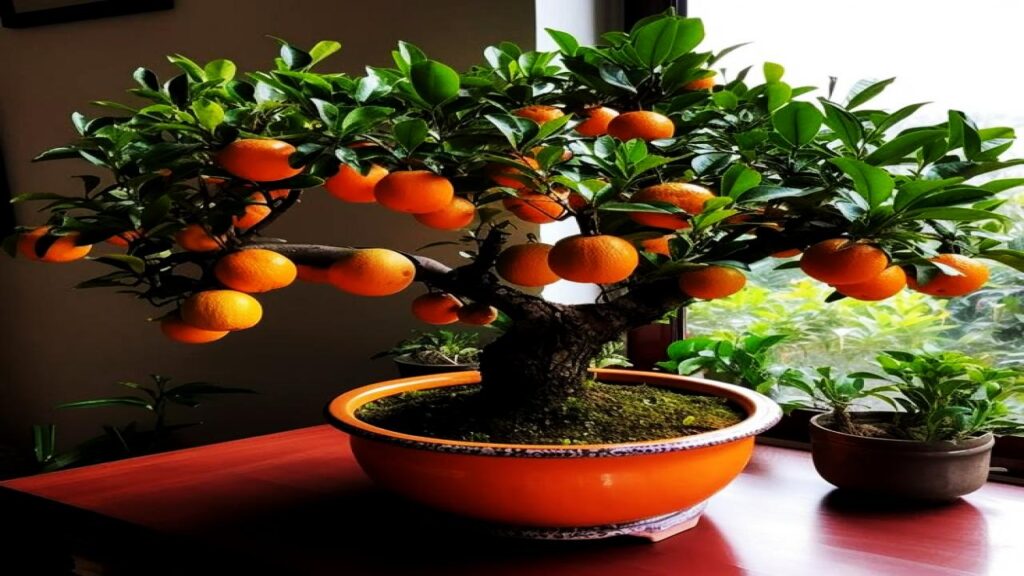
Figs (Ficus carica)
The rich, honeyed flavor of a fresh fig is a true luxury, and many varieties perform exceptionally well in containers. Potting can even encourage earlier fruiting. I find that the restricted root run actually signals the plant to focus on fruit production.
- Why they’re great for pots: Tolerant of root restriction; some varieties stay naturally smaller.
- Pot Size: A 15-gallon pot (around 18-20 inches in diameter) is a good eventual size for most varieties.
- Varieties to Try: ‘Brown Turkey’ (reliable and common), ‘Celeste’ (sweet, often called “sugar fig”), ‘Petite Negra’ (dwarf, fruits at a young age), ‘Little Miss Figgy’ (very compact).
- Care Tips: Full sun. Well-draining soil. Water regularly, especially in hot weather. Figs appreciate consistent moisture when fruit is developing. Fertilize a few times during the growing season with a balanced fertilizer. Prune in late winter to maintain shape and size. The University of Maryland Extension provides helpful insights on fig cultivation.
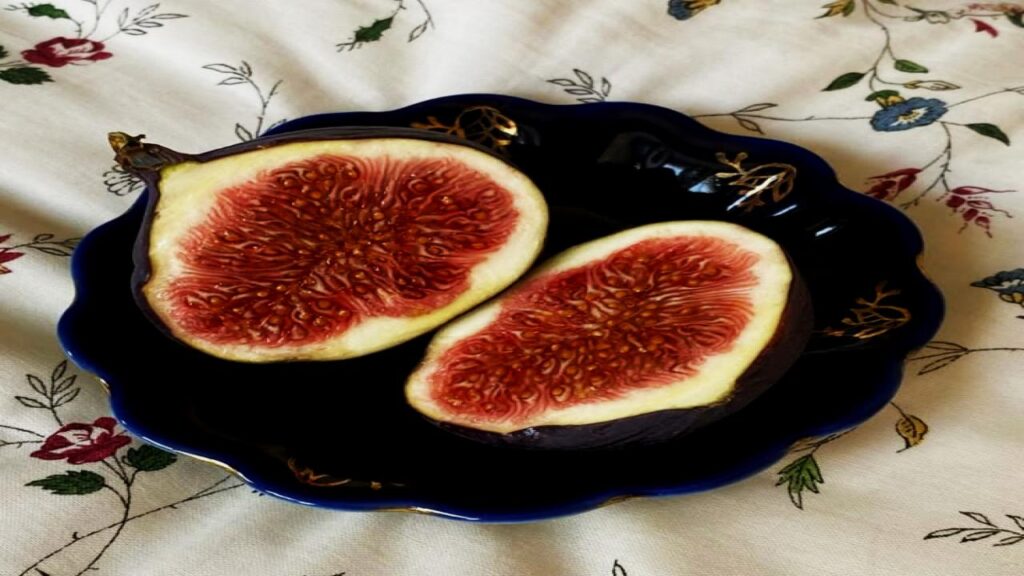
Dwarf Raspberries (e.g., Rubus idaeus ‘Raspberry Shortcake’)
Traditional raspberries can be rambling and a bit unruly for small spaces, but newer dwarf, thornless varieties are game changers for balcony fruit gardening. These compact bushes produce full-sized berries without needing extensive support. I was initially skeptical, but these little powerhouses really deliver!
- Why they’re great for pots: Specifically bred for compact growth; no complex trellising needed.
- Pot Size: At least a 10–12-inch pot, though a 15–20-inch (10-15 gallon) container is better for long-term health and yield.
- Varieties to Try: ‘Raspberry Shortcake’ (thornless, rounded habit), ‘Glencoe’ (thornless, purple fruit, can be kept compact).
- Care Tips: Full sun. Well-draining, slightly acidic to neutral soil, rich in organic matter. Keep consistently moist. Fertilize in spring with a balanced, slow-release fertilizer. Prune out old canes after fruiting according to the variety’s habit (primocane or floricane).

Dwarf Peaches & Nectarines (Prunus persica)
Yes, you can grow peaches and nectarines in pots! Genetic dwarf varieties, often called “patio” peaches or nectarines, stay remarkably small (typically 4-6 feet) but produce full-sized, delicious fruit. It’s a common mistake I see to buy a standard tree and hope to keep it small through pruning; starting with a true dwarf is much easier for container success.
- Why they’re great for pots: Bred for small stature; highly ornamental with spring blossoms.
- Pot Size: Start with a 5–7-gallon pot (12-14 inches) and move up to a 15–20-gallon (18-24 inches) pot as they mature.
- Varieties to Try: Peaches: ‘Bonanza’ (popular dwarf), ‘Pix Zee’, ‘Honey Babe’. Nectarines: ‘Necta Zee’, ‘Garden Delight’.
- Care Tips: Full sun. Well-draining, fertile potting mix. Regular watering is crucial, especially during fruit development. Fertilize with a balanced fertilizer in early spring and again after fruiting. These trees require some chilling hours to set fruit, so check suitability for your climate. According to the Stark Bro’s Nurseries & Orchards Co. (a reputable supplier), proper pot size and winter care are crucial.
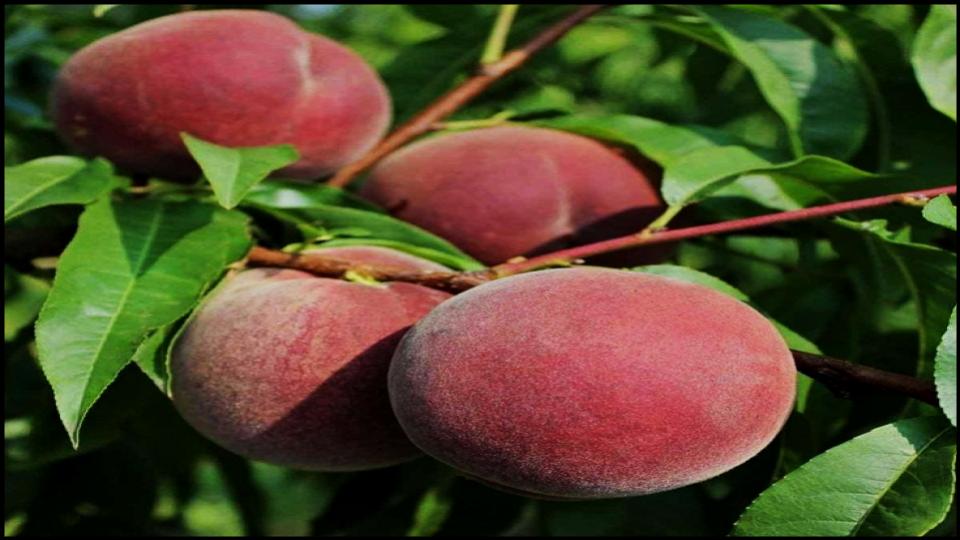
Columnar Apples (Malus domestica)
For a truly unique vertical accent in your small space edible garden, consider columnar apple trees. These slender trees grow upwards with very little side branching, producing spurs along the main trunk where fruit develops. They are perfect for tight spaces. Some are self-fruitful, but planting two different varieties that bloom around the same time often improves pollination and yield. I always suggest checking pollination requirements.
- Why they’re great for pots: Very narrow growth habit; excellent for small balconies or patios.
- Pot Size: A 10–15-gallon pot (16-20 inches in diameter) should be sufficient for a mature tree.
- Varieties to Try: ‘Northpole’, ‘Golden Sentinel’, ‘Scarlet Sentinel’. (Often sold as “Colonnade” apples).
- Care Tips: Full sun. Well-draining, fertile soil. Consistent watering. Stake young trees for support. Fertilize in early spring. Minimal pruning is usually required, mostly to remove any stray horizontal branches.
Calamondin Orange (Citrus mitis or x Citrofortunella mitis)
Another star among container fruit trees, the Calamondin orange is a wonderfully forgiving and highly productive small citrus. It produces masses of small, tart, orange-like fruits that can be used like lemons or limes in cooking or made into marmalade. Plus, it often fruits and flowers simultaneously, making it incredibly ornamental year-round.
- Why they’re great for pots: Naturally small and bushy, prolific fruiter, fragrant flowers.
- Pot Size: Start with an 8–10-inch pot, moving up to 15-20 inches as it grows.
- Varieties to Try: Standard Calamondin. Variegated forms also exist with beautiful foliage.
- Care Tips: Full sun to light shade (more sun equals more fruit). Well-draining potting mix. Water when the top inch or two of soil is dry. Feed with a citrus fertilizer during active growth. Like Meyer lemons, protect from frost.
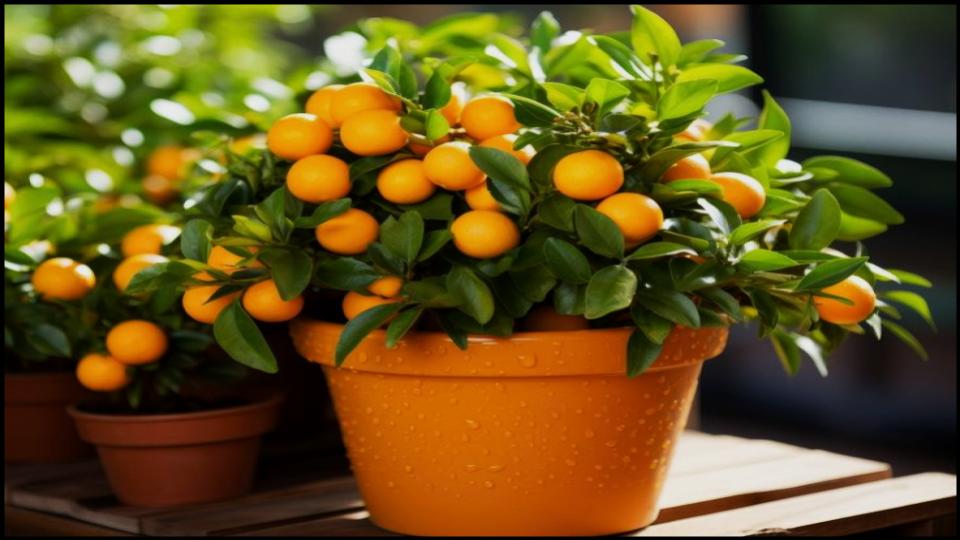
Essential Care for Your Potted Fruit Garden
Success with growing fruits in pots relies on a few key principles. While each fruit has its nuances, some care aspects are universal.
Choosing the Right Pot & Soil
The right container is foundational. Ensure your chosen pots have ample drainage holes – this is non-negotiable! Terracotta is attractive and breathable but dries out quickly. Glazed ceramic pots retain moisture better but can be heavy. Plastic or composite pots are lightweight and retain moisture well. As a rule of thumb, it’s better to go slightly too large than too small to allow for root growth. My personal preference for larger specimens like dwarf trees is often a half-whiskey barrel or a substantial composite pot.
For soil, don’t use garden soil, which compacts easily in pots. opt for a high-quality, well-draining potting mix. Many nurseries offer mixes specifically for containers. You can amend this with compost for added nutrients.
Sunlight & Watering Wisdom
Most fruit-bearing plants are sun worshippers, needing at least 6-8 hours of direct sunlight daily to thrive and produce well. Observe your balcony or patio throughout the day to identify the sunniest spots.
Watering is critical for container plants, as they dry out much faster than those in the ground. Check the soil moisture daily, especially during hot or windy weather, by sticking your finger a couple of inches deep. Water thoroughly until water drains from the bottom of the pot, then allow the top inch or two to dry out before watering again. Overwatering can be just as detrimental as underwatering.
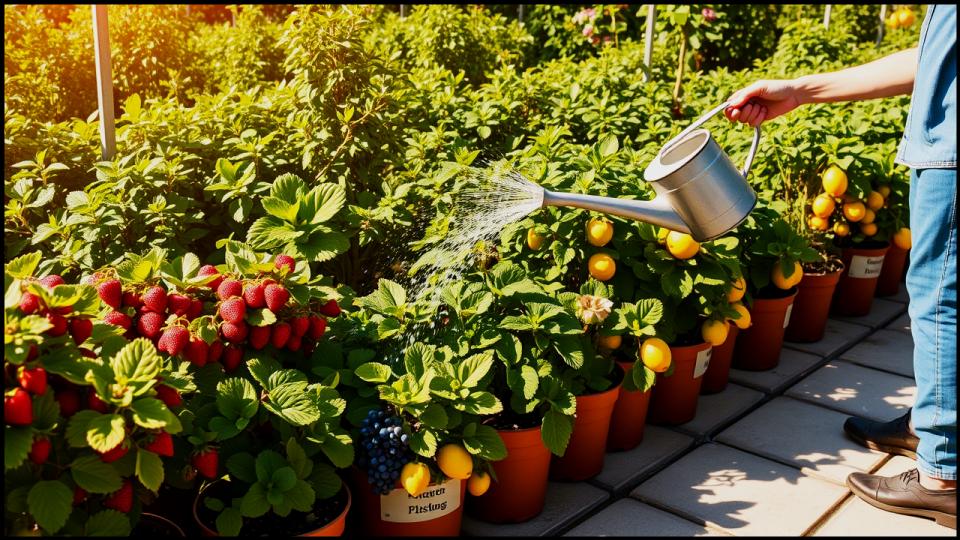
Feeding Your Fruiting Beauties
Potted plants have limited access to nutrients, so regular feeding is essential for healthy growth and abundant fruit. Use a balanced, all-purpose liquid fertilizer or a slow-release granular fertilizer formulated for fruiting plants or the specific type of fruit you’re growing (e.g., citrus food, acid fertilizer for blueberries). Follow the product instructions carefully – more is not always better! I generally feed my potted fruits every 2-4 weeks during the active growing season.
TOOLS AND MATERIALS BOX:
- Pots: Various sizes with drainage holes (terracotta, glazed ceramic, plastic)
- Potting Mix: High-quality, well-draining mix
- Fertilizer: Balanced liquid or slow-release granules; specific types for citrus or acid-lovers as needed
- Watering Can or Hose: For consistent watering
- Trowel: For planting
- Pruners: For light shaping and removing dead/damaged growth
- Plant Stakes/Supports: For young trees or vining types if chosen
- Saucers (optional but recommended): To catch drainage and protect surfaces.
Your Balcony Bounty Awaits
The journey of growing fruits in pots is a deeply rewarding one, bringing not only delicious harvests but also a touch of nature’s beauty to even the most urban settings. With the right plant choices and a little attentive care, your balcony or patio can become a vibrant, productive extension of your home. Imagine the delight of plucking a sun-warmed strawberry or a zesty lemon just moments before you enjoy it. This isn’t a distant dream, but an achievable reality. So, embrace the adventure, select your fruity companions, and get ready to taste the sweet success of your very own balcony fruit gardening efforts.
Read More
Are You Making These 7 Zinnia Growing Mistakes? Here’s How to Fix Them Fast
Avoid These 10 Plants at All Costs If You Have Clay Soil—Experts Reveal Why
